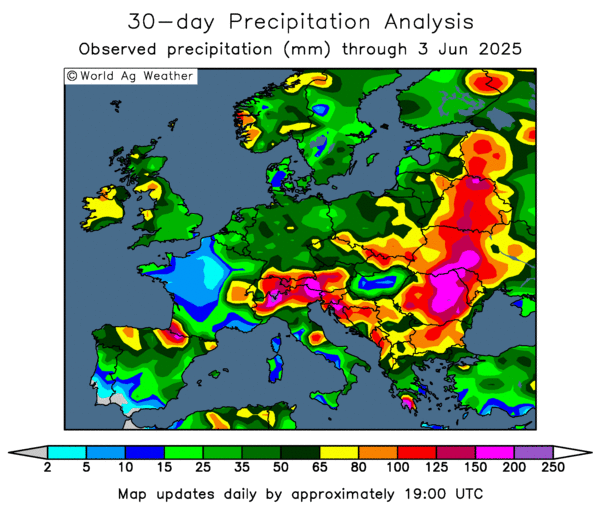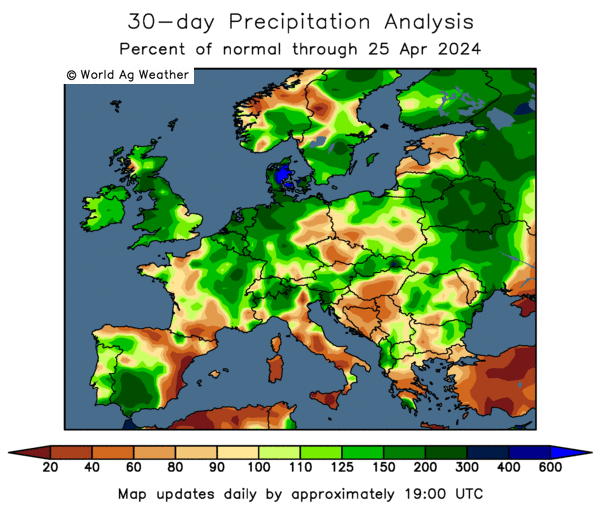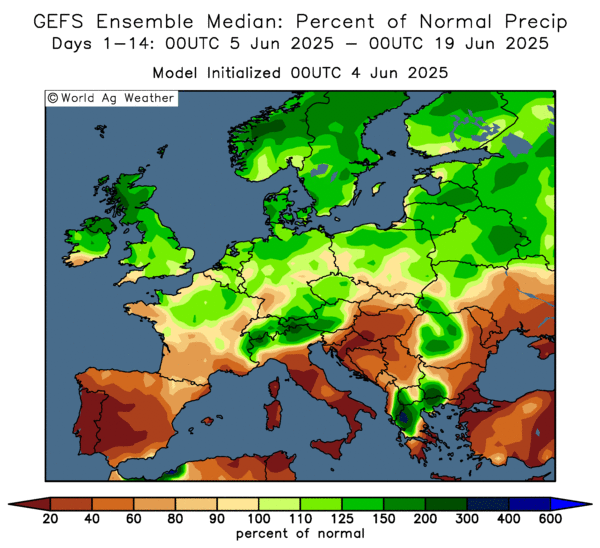Wheat: Living On The Edge
The wheat market has certainly taken quite a tumble in the past few weeks. Since recent June 1st highs we've seen London wheat fall 14%, with Paris down 13% and Chicago wheat 12.7% lower. That's some pretty hefty losses in just a fortnight.
For those that would blame the influences of the "outside markets" crude oil has actually risen 9% during the same period.
So what is it with wheat? Good old-fashioned supply & demand?
Lets have a look at supply, or to be a bit more specific world trade. According to the USDA the world's largest wheat exporters in 2008/09 will be:
The US, the EU-27, Russia, Canada, Australia, Ukraine & Argentina. These are the top six nations that keep much of the world supplied with wheat.
Let's have a look at their production prospects for 2009/10:
2008/09 (MMT) 2009/10 (MMT)
---------------------------------------------
US 68.0 57.0
EU-27 151.7 132.5
Russia 63.7 58.0
Canada 28.6 23.4
Australia 21.5 22.0
Ukraine 25.9 18.0
Argentina 8.3 7.7
---------------------------------------------
Total 367.7 318.6
---------------------------------------------
So the top six exporting nations that account for over half of world production and 87.5% of global trade in wheat are set to see their output fall by almost 50 MMT in the year ahead.
Indeed, it looks a nailed-on certainty that Argentina won't even have any wheat to export at all in 2009/10, and will probably be a net importer (despite the fact that the USDA currently has them down to export 4 MMT next season).
So it must be world demand that's falling then? The world's top six importers, and their likely requirements for 2009/10, according to the USDA:
2008/09 (MMT) 2009/10 (MMT)
---------------------------------------------
Egypt 9.5 8.5
Iran 8.5 6.0
EU-27 6.5 6.5
Brazil 6.0 5.7
Algeria 5.6 5.4
Japan 5.5 5.5
---------------------------------------------
Total 41.6 37.6
---------------------------------------------
So the top importing nations are seen using 4 MMT less in 2009/10, well that's handy, if they were planning on buying it from Argentina, they'll probably find that it isn't available anyway!
So where's the rest of the production shortfall coming from, how are we going to feed the world? Global stocks of course. So with global wheat stocks having been in steady decline since 1998/99, we've had one decent harvest to help replenish them before we start digging into them again.
And what happens if Australia have another El Nino drought year? That could wipe another 10 MMT off world supply quite easily.
We do like to live on the edge don't we?
2009 World Wheat Plantings - Informa
Informa Economics projects the global wheat area in 2009 at 222.4 mln ha which is just 1.8 mln ha or 1% below the 224.2 mln ha planted this year.
The area in the EU is expected to fall to 26.3 (26.6) mln ha, in Russia to 25.5 (26.7) mln ha, in China to 22.5 (24.0) mln ha, in the USA to 21.4 (22.5) mln ha, in Kazakhstan to 13.1 (13.3) mln ha, and in Ukraine to 6.5 (7.0) mln ha.
In Australia, the area is expected to increase to 13.5 (13.0) mln ha and in Argentina where drought cut plantings this year to 5.3 (4.3) mln ha.
The wheat area in India should remain unchanged at 28.0 mln ha, they say.
The figures are a little higher than those released recently by the IGC who pegged world wheat plantings down 1.6% to 221.7 mln ha, with EU wheat plantings at 25.9 mln ha.
Nogger's Weekend Wheat Wire
EU wheat futures closed lower Friday with Paris January milling wheat down EUR1.25 to close at EUR134.25/tonne. London January feed wheat closed down GBP1.85, or 2%, at GBP92.65/tonne.
In a week of mixed signals for wheat currency is becoming more and more important. Every wheat exporting country around the globe, with the possible exception of Argentina has wheat to sell. How you local currency is faring against the dollar detirmines how competitive, or otherwise, your country's wheat is on the export arena.
With the pound posting it's biggest gain in percentage terms against the dollar this past week since 2000, then it's maybe no surprise that UK wheat hasn't found much interest.
What a contrast from a couple of weeks ago when we were exporting UK wheat to America! Since then however, the pound has climbed from $1.48 to $1.54, that has been enough to knock our competitive edge, and the same US buyer has subsequently bought Brazilian wheat.
Still, it's not all doom & gloom, at least not for exporting wheat, with many pundits saying that there is only one outlook for sterling in the foreseeable future, lower. A steady stream of disappointing economic data added further gloom to British economic forecasts, and the general mood remains dour for the British Pound.
The outlook for UK interest rates is still sharply lower, and the pound could still fall to $1.4100 by the end of the year, BNP Paribas said earlier in the week.
Well, if British wheat can find export homes in the US, of all places, with the exchange at $1.48 then it's certainly going to be competitive if we hit $1.41 then isn't it?
The main problem as we all know for our domestic crop is that we haven't got a quality card to play.
Looking further ahead, the jury is well and truly out on prospects for 2009 and beyond. World plantings are forecast only slightly down (-1.6%) by the IGC, still even just a 1.6% reduction in output would equate to 28 million tonnes less wheat next season.
Global ending stocks for the current 2008/09 season are pegged at 307 million tonnes by the IGC. That might sound like a lot of wheat, but in reality it is only two months supply, so it's actually still quite tight.
World demand isn't going to get any smaller, despite the recession. Many analysts reckon that, by mid-2009, globalisation will quicken, with China, India, Russia and Brazil all increasing their economic strength. Emerging economies, whilst they might see economic growth drop from 8% to 6% in 2009, are still growing. And so is their appetite for meat. Global meat consumption is seen up 2% in 2009/10, according to the IGC. This had led to a steady and continuing expansion of the Chinese pig herd and poultry flock, for example, which required extra quantities of feed grain.
The big unknown for next season are what are yields going to be like? It seems unlikely that the entire northern hemisphere will escape with virtually ideal growing conditions next time round. In addition, how much fertiliser is going to be used with prices doubling, whilst wheat has halved, compared to twelve months ago?
It's early days yet, but on the balance of probability, world wheat production in 2009/10 will be lower than presently forecast. Perhaps significantly so. I don't see demand decreasing. Maybe the financial stimulus packages announced by governments the world over will finally be trickling through and making a difference by then too?
We shall see, whatever, I'm modestly bullish wheat for the second half of 2009.
Up To 32M Acres Of Farmland Lays Idle In Eastern Europe - FAO
The UN Food and Agriculture Organization (FAO) and the European Bank of Reconstruction and Development (EBRD) say that as much as 32.1 million acres of unused farmland lays idle in Eastern Europe and the Commonwealth of Independent States (CIS) – 12 of the 15 former Soviet republics.
Despite Russia and Ukraine producing bumper harvests of cereal crops this year due to high food prices, the region still possesses significant untapped agricultural potential, a senior United Nations (UN) food agency official said Thursday at the opening of a two-day meeting in Paris on agricultural developments in the region.
Rising food prices have led to rapid expansion of land used for agriculture in the two countries with an increase of 5.9 million acres to 83.5 million acres of farmland planted to wheat, according to the FAO.
In Russia alone, harvested area for wheat, course grains and rice is forecast at nearly 113.7 million acres for the 2008 harvest, which is up 6.4 million acres from 2007.
"This clearly shows that higher prices can be an opportunity for the farming community," Charles Riemenschneider, Director of FAO's Investment Centre, said in a UN press release.
According to FAO figures, wheat production in the European CIS countries is set to rise to more than 73 million metric tons in 2008 – up 13 percent from last year.
"In March we discussed opportunities for enhancing agricultural output, and we can see from these figures that benefits are already materializing that could make a real difference on world markets," Riemenschneider said in the press release.
"These countries have significant exportable cereal surpluses, but more long-term investment is needed to ensure that this supply response is sustainable," he said.
USDA World Wheat Output Up 6.5MMT To 670.8MMT
USDA -- Global 2008/09 wheat production is projected at a record 670.8 million tons, up 6.5 million from last month and 60.2 million higher than last year. Increases for EU-27, India, Russia, Ukraine, and the United States more than offset reductions for Afghanistan and Argentina. EU-27 production is increased 1.5 million tons. India production is raised 1.6 million tons in line with government estimates. Production for Russia is raised 3.0 million tons reflecting increased harvested area and higher expected winter wheat yields as indicated by harvest results to date. Ukraine production is raised 1.0 million tons despite a small reduction in harvested area as a result of recent flooding in western growing areas. Harvest results indicate higher yields for winter wheat in Ukraine. Production is lowered 1.0 million tons each for Afghanistan and Argentina. Severe drought and lack of snow melt for irrigation have sharply reduced harvested area and yields in Afghanistan. In Argentina, continued dryness in central growing areas, as well as uncertainty about government export policies have reduced planted area.
IGC Increases 08/09 World Wheat Crop Estimate 4MMT
According to the International Grains Council (IGC), world wheat production prospects have improved during the last month and a record crop of 662 million tonnes is now forecast for 2008/09.
The projection is 4 million tonnes up from an estimate issued last month and 54 million or nearly 9 percent up from last year when drought devastated crops in several regions, the IGC said in a monthly report.
"The outlook improved in the EU, Russia, Ukraine, the U.S., Brazil, India and Australia but worsened in Argentina and in Near East Asia," the report said. World maize production in 2008/09 was projected at 759 million tonnes, up from a previous forecast of 756 million but still well below the prior season's 785 million.
"Rains benefitted (wheat) crops in key producing areas but delayed harvesting and put quality at risk in parts of the EU, Ukraine and the U.S.," the IGC said.
Wheat - the BIG supply picture
A comment in a report for last night's CME wheat close ("We're going to be swimming in wheat next year") got me thinking this morning. So I decided to do a bit of research into some firm numbers on world wheat production for the coming year.
In the UK wheat production could rise 20 percent this year assuming a return to average yields with the planted area set to climb 13 percent, according to analyst Susan Twining of ADAS. "Yields were down last year and even if you work on average yields of 7.8 tonnes per hectare that takes production above 16 million tonnes which is a 20 percent increase," Twining added. Britain's farm ministry has put 2007's UK wheat crop at 13.36 million tonnes, down from 14.74 million lain 2006 with average yields at 7.3 tonnes versus 8.0 tonnes in 2006. Twining said the rise in wheat area reflected the suspension of set-aside, the woes of Britain's livestock sector and high prices for the commodity.
In Europe as a whole Strategie Grains is forecasting that European Union (EU) 27 wheat production will skyrocket from 2007’s 111.5 million tonnes to 128.6 million tonnes in 2008 (a 15% increase). They see wheat area expanding in the EU 27 by 4% and yields going up 11% in 2008.
Ukrainian wheat production this year is expected 30% higher and wheat area 40% larger than last year. This would put production in the 17.5 to 18. 5 million tonne range, around 4-5mmt up on 2007-08.
SovEcon estimates that this year’s Russian wheat crop will come in at 31.4 million tonnes. That is well above the 2002-06 average of 24.8 million tonnes.
As we all know the USDA release their US acreage estimates on Monday. Meanwhile, Informa Economics is forecasting that US wheat acres will climb to 63.526 million acres next crop year from this crop year’s 60.433 million acres. That is a 3.093 million acre (5.1%) increase. Using 2007's average yield of 40.5 bu/acre that gives us approximately 125m bushels more in 2008, or 3.4 million tonnes.
The Canadian Wheat Board sees the Canadian wheat crop coming off at 28.8 million tonnes, an increase of 8.7mmt (or around 44%) from 2007-08's 20.1mmt.
In their February forecast, ABARE increased their estimate of last season's 2007-08 Aussie wheat crop by 400,000 tonnes to 13.1 million tonnes. ABARE sees the Aussies harvesting almost 26 million tonnes of wheat in 2008, an increase of nearly 13mmt, some analysts are forecasting production even higher at a record 27mmt, IF of course mother nature conforms. That would give us an increase of 13-14mmt.
The International Grains Council is forecasting world wheat production to climb 42.6 million tonnes (about 7%) next crop year to 646.2 million tonnes. Informa Economics thinks that the 2008-09 number will be 650 million tonnes.


















